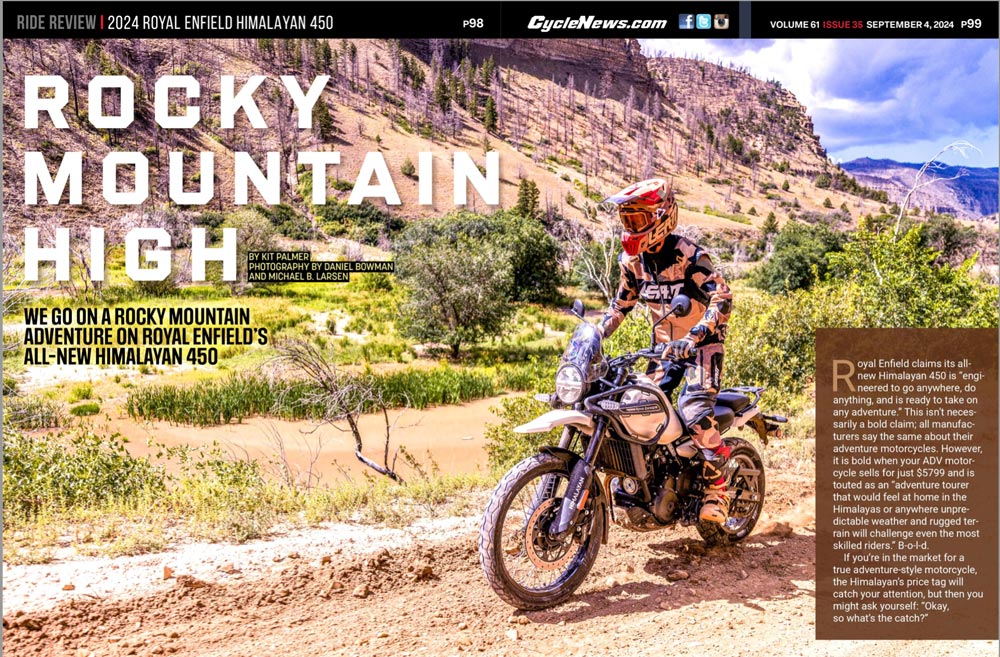Kit Palmer | September 12, 2024
Royal Enfield claims its all-new Himalayan 450 is “engineered to go anywhere, do anything, and is ready to take on any adventure.” This isn’t necessarily a bold claim; all manufacturers say the same about their adventure motorcycles. However, it is bold when your ADV motorcycle sells for just $5799 and is touted as an “adventure tourer that would feel at home in the Himalayas or anywhere unpredictable weather and rugged terrain will challenge even the most skilled riders.” B-o-l-d.
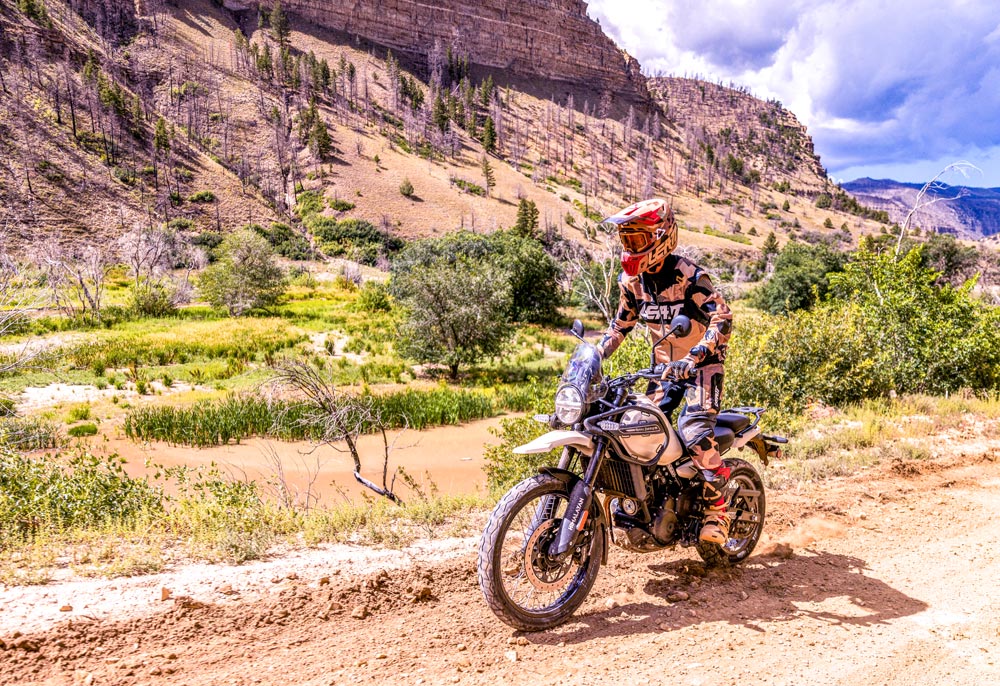
If you’re in the market for a true adventure-style motorcycle, the Himalayan’s price tag will catch your attention, but then you might ask yourself: “Okay, so what’s the catch?”
Well, there are a couple of possible catches. First, the Himalayan is a single, and a relatively small 450cc single, that you might find not beefy enough for hard-core adventuring. That right there might be enough to scare you off. Secondly, the Royal Enfield’s are built in India, which a lot of people aren’t comfortable with yet, just like when Japanese-built bikes first started flooding the U.S. market many years ago. Otherwise, these are probably the main issues that could make you walk away from the Himalayan despite its tempting $5799 base price. (You could pay a little more depending on your chosen colorway; the highest is $5999.) But should the Himalayan’s engine size and where it’s built turn you off? Read on and find out.
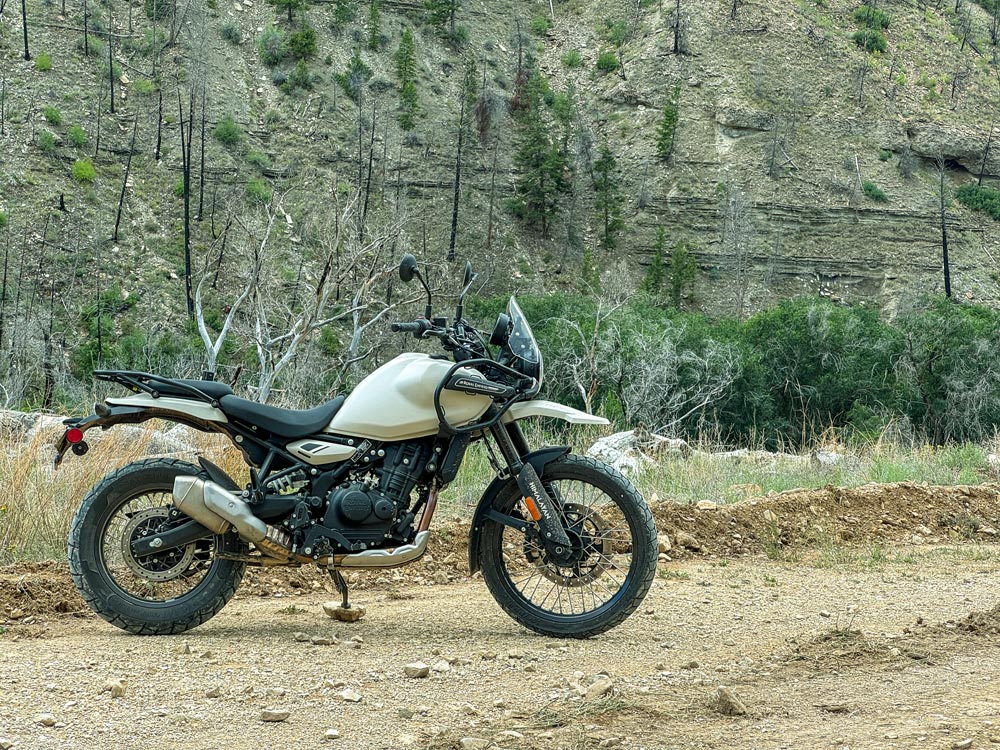 The new Himalayan 450 might not be a looker but it’s a good all-around performer.
The new Himalayan 450 might not be a looker but it’s a good all-around performer.
Background | 2024 Royal Enfield Himalayan 450 Review
Over its 124 years in the motorcycle industry, Royal Enfield, with its English heritage, has been known for its traditional approach and minimal changes. Since establishing its Chennai plant in India in 1956, the company has focused on serving the Indian market while gaining recognition in Europe and the U.S.
The first Himalayan was introduced in 2015 and launched in 2016. It was powered by a 411cc single-cylinder air-cooled engine that pumped out 23 horsepower. It arrived in the U.S. in 2018 and was warmly received for its casual, laid-back backroads cruising and around-town hauler mannerisms more than it being a genuine high-mileage, all-terrain adventurer. Its $4300 price tag was easy to swallow, too, as were its nostalgic looks. Since then, the original Himalayan has been updated a few times and has seen modest price increases over the years, but now gets a complete makeover, which includes a brand-new, more powerful engine and, yes, a price increase. The new Himalayan was first launched late last year for the European market.
 The Himalayan isn’t afraid to get dirty.
The Himalayan isn’t afraid to get dirty.
What’s New? | 2024 Royal Enfield Himalayan 450 Review
The all-new Himalayan stands far apart from its predecessor. It boasts the company’s new modern Sherpa 450 engine and electronics package, and a more capable chassis. Every part of the new Himalayan is unique and doesn’t share any components with the previous model.
The all-new Sherpa 450 engine is the bike’s headline act. It signifies a major advancement for the company, marking its most significant progress in over 50 years. The decision to make such a radical leap forward is driven by various factors, including the need to meet modern emissions standards and the desire to enhance the bike’s competitiveness as the company ventures beyond the Indian market.
The all-new Sherpa 450 engine is Royal Enfield’s first liquid-cooled powerplant. It has a displacement of 452cc and features a forged piston in an aluminum cylinder with low-friction coating. The engine also has a four-valve head with overhead cams and more efficient intake tracts. It uses electronic fuel injection and a semi-dry sump design for lubrication. Power is transferred through a wet, multiplate clutch to a six-speed transmission and chain final drive. Peak power is now a claimed 39.6 horsepower at 8000 rpm with peak torque of 29.5 lb-ft at 5500 rpm. The Sherpa 450 powerplant is also 10 pounds lighter.
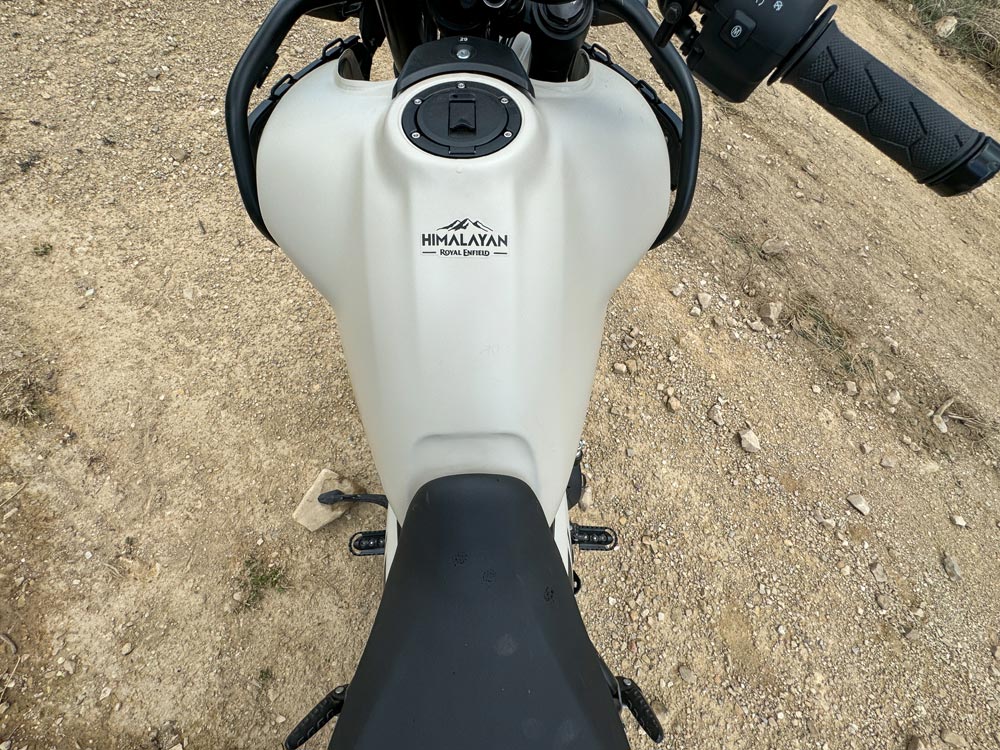 Despite its generous 4.5-gallon capacity, the Himalayan has a small waistline and feels narrow between your legs.
Despite its generous 4.5-gallon capacity, the Himalayan has a small waistline and feels narrow between your legs.
The new Himalayan features a twin-spar, tubular-steel frame, 43mm inverted Showa SFF fork, and Showa monoshock with preload adjustability. It has 21-inch front and 17-inch rear wheels, nine inches of ground clearance, and a wheelbase of 59.4 inches. The front-end geometry measures 26.5 degrees of rake with 5.0 inches of trail; they had stability in mind when designing this new Himalayan.
The bike uses ByBre brakes, a brand owned by Brembo and designed for the Indian market. It has a 320mm front disc, twin-piston caliper, and braided steel lines. In the rear, there is a single-piston caliper and a 270mm disc. The Himalayan has standard dual-channel ABS that can be turned off at the rear.
Royal Enfield knows that seat height alone can be a dealbreaker for ADV bikes, so the Himalayan offers two seat options—standard and an optional low seat. Each seat has two easily adjustable height settings. The standard seat offers heights of 32.5 and 33.3 inches, while the low seat offers heights of 31.7 and 32.5 inches.
The bike’s payload capacity is 436 pounds.
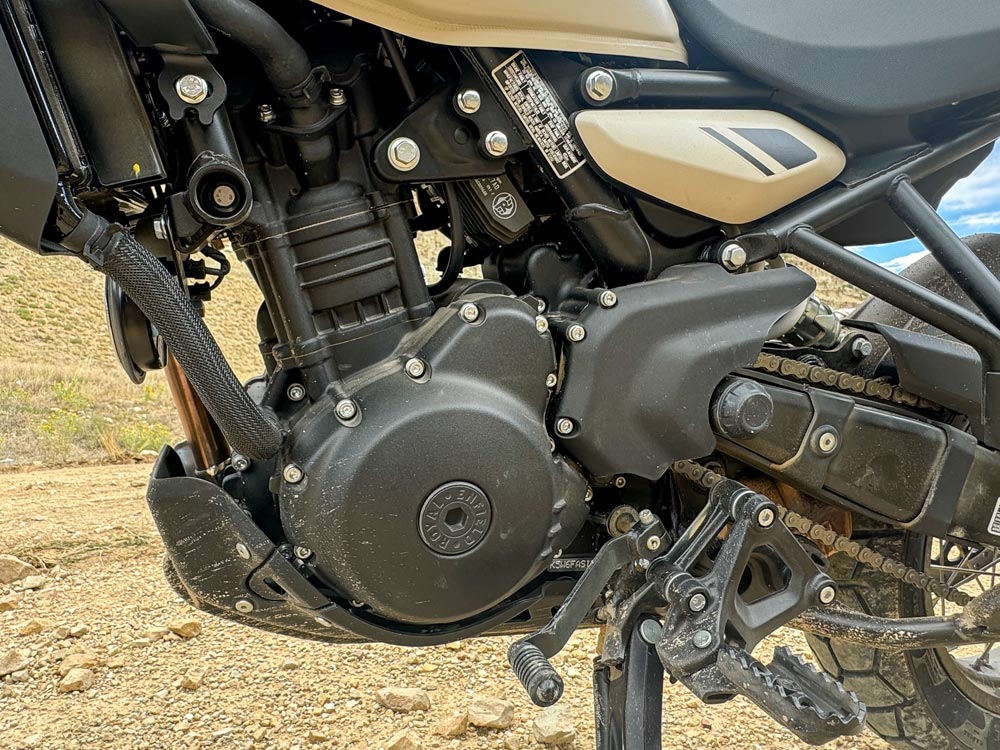 Welcome Royal Enfield’s first water-cooled engine.
Welcome Royal Enfield’s first water-cooled engine.
The new Himalayan has modern electronics, including a new ride-by-wire throttle control system. This allows for different ride modes: Performance/ABS On, Performance/ABS Off, Eco/ABS On, and Eco/ABS Off. You can’t switch modes on the fly. You need to select your preferred mode when you start the bike and come to a stop if you want to change it, such as if you’re transitioning from asphalt to dirt and want to disable the rear ABS and vice versa.
The bike’s new Tripper dash gives you access to all the different modes and electronic features. It’s a round four-inch, full-color TFT display that provides smartphone connectivity, media controls, and full-map navigation using a Google-based navigation engine. You can customize the display to show the most important information. The navigation system lets you choose between a full-map view or simple directional arrows. There’s also a USB-C charging point and full LED lighting, including dual-function turn indicators and brake lights.
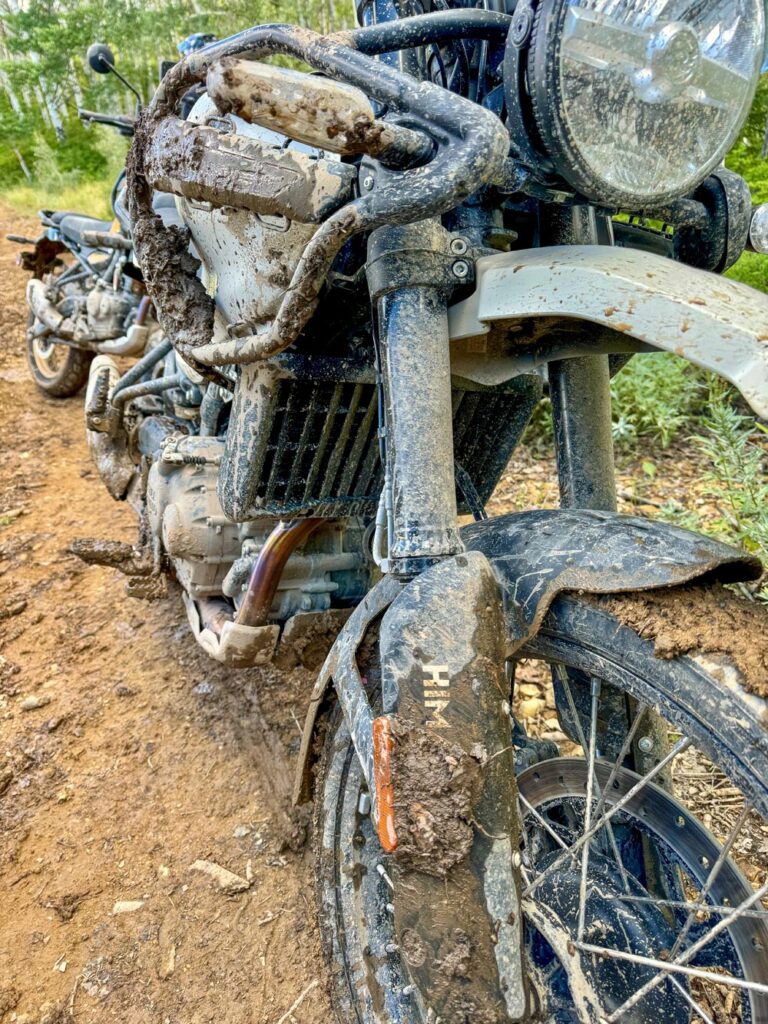 A dirty Himalayan is a prettier Himalayan.
A dirty Himalayan is a prettier Himalayan.
Time To Get Dirty — Mission Accomplished
The all-new Himalayan will officially enter the North American market this month (September 2024) when bikes start showing up on showroom floors as a 2024 model. The company recently held its official U.S. launch in the Rocky Mountains near Park City, Utah, attended by several U.S. media outlets, Cycle News included. Despite the horsepower-sapping 7000-8000-foot elevation, Royal Enfield had no qualms about showing off its new single-cylinder Himalayan in the thin air.
Our ride began just outside the lobby of our mountain lodge with a lengthy jaunt on the pavement before the fun stuff started. On the open road at approximately 8000 feet elevation, the Himalayan’s power wasn’t anything to get excited about but it was better than I expected. The bike did not feel like it was laboring while holding a steady 65-70 mph. A slight buzzing could be felt in the handlebars and footpegs, but not enough to hamper the ride. For my 6’1” build, the bike felt a tick on the small side, but I immediately felt comfortable on it, so I knew that a long day in the saddle would not be a problem. The Himalayan has a tiny windscreen, which I prefer over larger ones—no helmet buffeting or visual distractions here. Even the small, round dash is discreetly positioned but is easy to decipher. For me, the Himalayan easily passed our short road test.
Approximately 90 percent of our 120-plus-mile ride took place on the dirt, mostly Jeep roads, some deeply rutted, as we gradually climbed in elevation on what was a sunny, 80-degree day in the Rockies. Our bikes were fitted with the original, Indian-made CEAT—I’d say 80 (street) / 20 (dirt)—tires, so I was a bit cautious when we first transitioned onto the dirt but found the tires to offer better-than-expected grip.
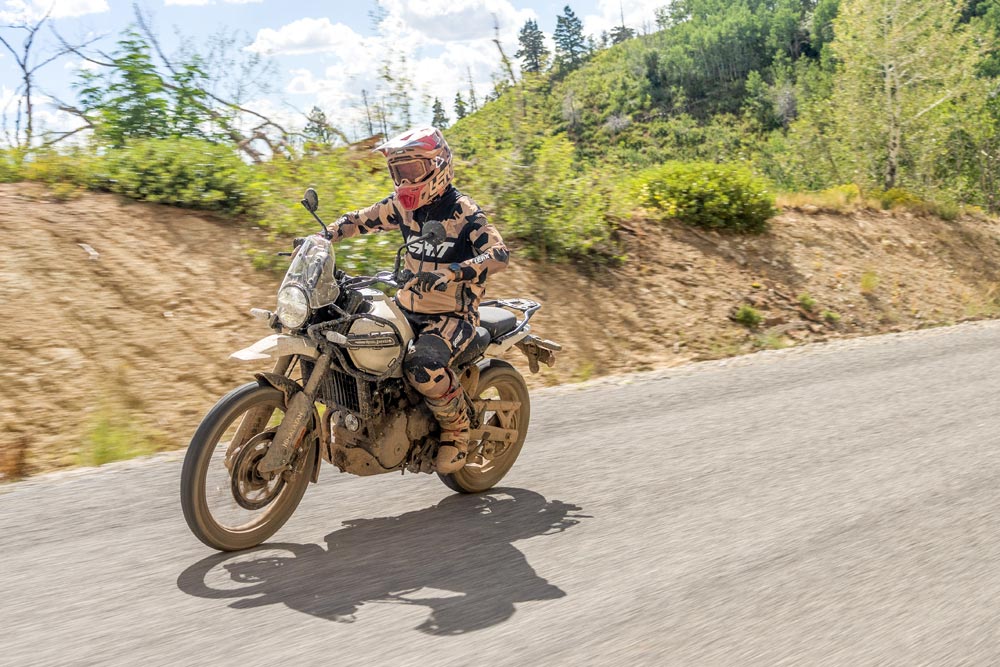 The Himalayan feels very dual sport-ish.
The Himalayan feels very dual sport-ish.
The best of the Himalayan comes out in the dirt. The bike handles well and predictably, and the suspension is quite good right out of the box. For my 165 non-gear-laden pounds, I didn’t feel any immediate need to make suspension adjustments, though I did raise the seat, which took all of two minutes, if that, to complete.
As we climbed, the dirt roads became increasingly challenging, mainly because of deep ruts and seemingly hundreds of ridiculously slippery clay-like mudholes that had formed from thunderstorms the previous day and were to blame for several minor get-offs among the many journalists on the ride. No one blamed the bike for the mishaps, but the street tires certainly didn’t help. For me, the Himalayan’s low seat height, “light” weight and dirt-bike-like ergos saved the day for me. My handlebars never touched the ground, though they did come close a few times. It was a real workout for several miles.
The Himalayan feels more like a Japanese-style dual sport bike than your typical adventure bike in that it is extremely easy to ride, very maneuverable and not in the least bit intimidating, mainly because of its small-ish overall size and user-friendly motor. And I rarely wished for more power from the Himalayan on the dirt; sure, it would’ve been nice to have a bit more of an acceleration rush out of the turns, but overall, I went as fast as I wanted to go on the dirt when I was on the Himalayan. I never felt its “lack” of power held me back or diminished any of the fun. In fact, it was probably the opposite; it’s like riding a small-bore Japanese dual sport, where you can get the most out of the bike rather than higher-end and ultra-powerful adventure bikes getting the most out of you. And riding with other Himalayans raised the fun meter another notch.
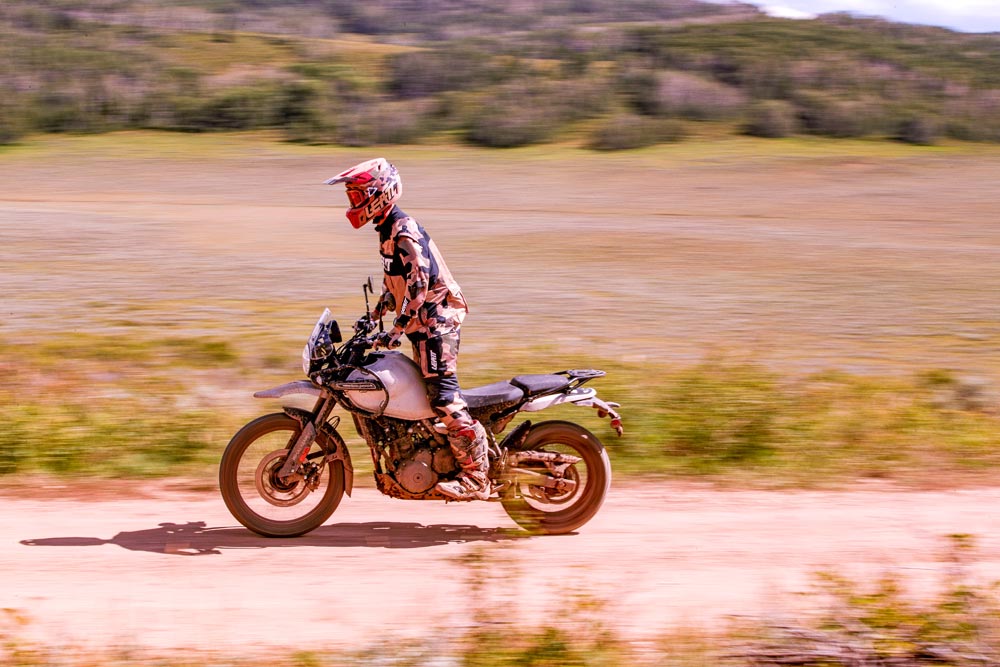 The new Sherpa 450cc engine might lack raw horsepower, but the rest of the bike has a lot to offer.
The new Sherpa 450cc engine might lack raw horsepower, but the rest of the bike has a lot to offer.
The Himalayan is not a handsome motorcycle. However, this actually improved my riding experience on the bike. I’ll explain. I always feel guilty about getting a pretty, high-dollar ADV bike dirty or, God forbid, dropping one. I had no such anxieties on the Himalayan. I had no reservations about aiming straight for the middle of mudholes and submerging the bike up to its engine cases in brown muck. The Himalayan looks better plastered in mud anyway. Dropping the bike is not an issue since it has no fairing, has no expensive plastic parts to break, is covered in crash guards, and is “easy” to pick up. Remember all those get-offs I was telling you about earlier? Not one bike that I saw suffered any significant damage.
Disengaging the rear ABS and changing engine modes is very simple, especially the rear ABS. You just press a button on the right handlebar a few times, and you’re done. The rear ABS resets itself whenever you turn the bike off via the key, but controlling the ABS system is so easy that it’s not a problem or annoying. Other manufacturers should take note.
We rode well over 100 miles on the Himalayan, including many miles of throttle-to-the-stop riding, and didn’t even think about refueling. It’ll go farther than you will on a tank of gas; Royal Enfield says it can cover up to 280 miles on a tank.
Overall, I thoroughly enjoyed riding the Himalayan 450. It performed far above my expectations, and I anxiously await another opportunity to ride it again, perhaps closer to sea level, to feel how the engine performs there. It should be even better.
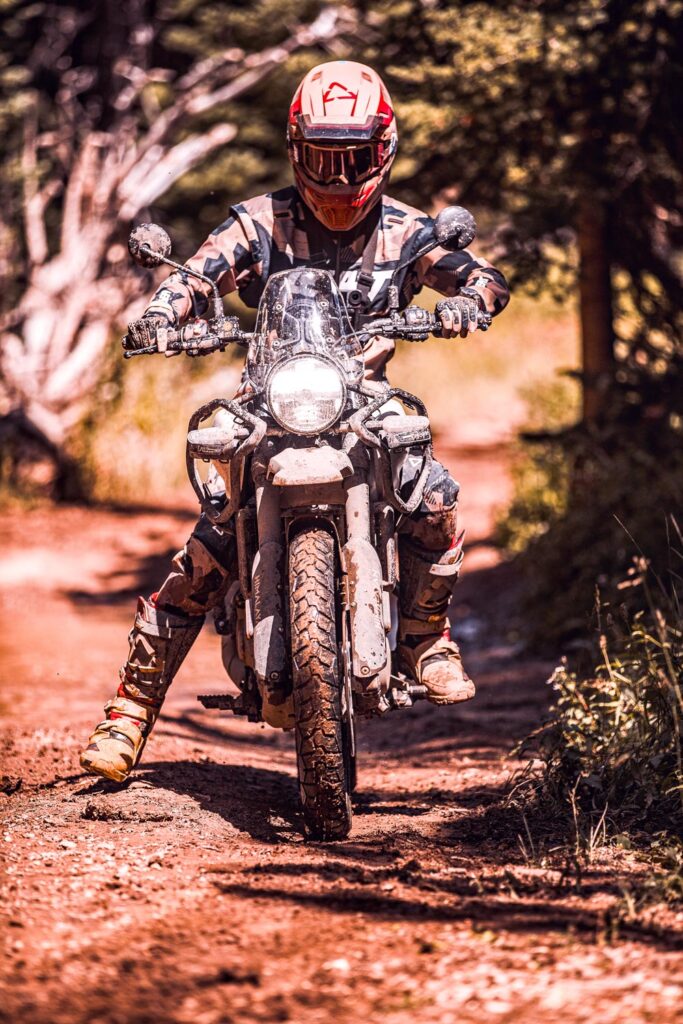
Final Thoughts | 2024 Royal Enfield Himalayan 450 Review
The Himalayan 450 must be considered one of the best values in adventure motorcycling, if not the best. The bike will accommodate riders of all shapes, sizes, and skill levels. It’s powered by a modern engine mated to a solid chassis with good suspension. You also get what appears to be top-of-the-line navigation, which Royal Enfield demonstrated for us, and that good-looking updated dash. Royal Enfield also offers a range of accessories for the Himalayan 450.
This is a genuine adventure bike, without question. It may be smaller and relatively simple compared to most of the other offerings in the market, but that gives it a big advantage in many situations, especially off-road, where low weight, low seat height and good agility are more important than raw power. However, if most of your ADV rides include logging lots of Interstate miles, you will want something with more displacement.
Royal Enfield’s Himalayan is truly versatile. While it might not be the outright best in dirt or on the street, it’s already proven to me to be a very competent adventure motorcycle for both. And the fact it’s built in India shouldn’t be a concern. We’ve reviewed several Royal Enfield models since 2016 and haven’t experienced any quality issues that would keep us away just because it’s built in India. The Himalayan appears to be no different. Plus, Royal Enfield’s dealer network is rapidly growing, which should make owning the Himalayan even easier.
And here’s the cherry on top—not only does the Himalayan sell for under six grand, but it also comes with a three-year, unlimited mileage warranty! It just keeps getting better.CN
VIDEO | 2024 Royal Enfield Himalayan 450 – First Ride Review
2024 Royal Enfield Himalayan 450 Specifications
| MSRP |
$5799 |
| Engine |
4-stroke, single |
| Displacement |
452cc |
| Valvetrain |
DOHC, 4-valve |
| Bore x Stroke |
84.0 x 81.5mm |
| Compression Ratio |
11.5:1 |
| Cooling System |
Liquid |
| Transmission/Final Drive |
6-speed/chain |
| Claimed Horsepower |
40 hp at 8000 rpm |
| Claimed Torque |
29.5 lb-ft at 5500 rpm |
| Fuel System |
Fuel injection w/ 42mm throttle body |
| Clutch |
Wet, multiplate slipper/assist |
| Engine Management/Ignition |
Ride-by-wire/electronic |
| Frame |
Steel twin-spar tubular |
| Front Suspension |
43mm Showa SFF inverted fork |
| Rear Suspension |
Showa monoshock, preload adjustable |
| Front-Wheel Travel |
7.9 in. |
| Rear-Wheel Travel |
7.9 in. |
| Front Brake |
ByBre 2-piston caliper, 320mm disc w/ switchable ABS |
| Rear Brake |
ByBre 1-piston caliper, 270mm disc w/ switchable ABS |
| Wheels, Front/Rear |
21 in./17 in. |
| Tires, Front/Rear |
90/90-21 / 140/80-17 |
| Rake/Trail |
26.5°/5.0 in. |
| Wheelbase |
59.4 in. |
| Ground Clearance |
9.0 in. |
| Seat Height |
32.5 to 33.3 in. |
| Fuel Capacity |
4.5 gal. |
| Claimed Wet Weight |
432 lb. |
| Colors |
Kaza Brown ($5799), Slate Himalayan Salt ($5899), Slate Poppy Blue ($5899), Hanie Black ($5999) |
| Country of Origin |
India |
